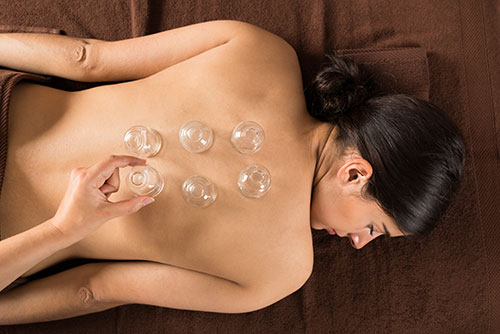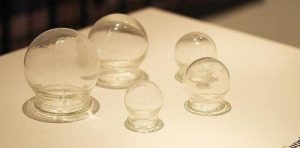Why Try Cupping?
I was a mess.
I felt sick and listless. I constantly felt like I had a fever (even when I didn’t). I found it hard to focus. My husband and children found it very hard to be with me in these times. I felt my life at home was falling to pieces. My doctor could do nothing. Can you imagine how helpless I felt? Then, I discovered cupping.
Or I should say: I rediscovered it.
Cupping is not new. It’s a very old traditional Chinese practice. It’s been helping people for thousands of years. I decided to go to my traditional acupuncturist who also advertised cupping. It was very strange at first, but I got used to it. I was so glad I went!
Within three weeks, I felt like a new woman. I started thinking of the many other men and women my age who complained of feeling the same way. We’re only forty-five or so, but we sometimes feel like we are ninety! I decided to tell you more about cupping, in hopes that it can help you if you feel the way I did back then before I rediscovered cupping.
What is Cupping?
Cupping is a very simple practice with effects that aren’t well understood.
A cupping therapist carefully cleans the skin on the affected parts of your body. This could be your back, arms, legs, or even your bottom. Then, 99% alcohol is placed on your skin. With a glass vessel (also known as a cup) held over the skin, the therapist lights the alcohol on fire. The cup is then quickly placed against the skin. The air is sucked out of the cup as the fire goes out, and pulls the underlying skin up with it into the cup.
It’s at this time in my story when I hear people scream, or I see them make a scary face. Cupping sounds far worse than it really is: It feels good! However, it can look terrible to people from a distance. Your skin is pulled up into the cup and it turns red or even purple due to the pressure.
The feeling to the patient isn’t bad at all. It’s a feeling of warmth and pressure, combined with the sense of a gentle tug on your skin. It’s not painful. In fact, there are new methods of cupping that don’t even require the use of fire.
After a period of about three minutes or so, the cups are removed. The therapist rubs some moisturizing lotion on the area.
That’s the complete cupping experience. Sounds simple, no?
How Cupping Works
It’s very hard to answer the question “How does cupping work?” Many sources complain cupping has no scientific validity, but that often only means that scientists haven’t studied it closely enough, or are using methods based on reduction rather than the larger, holistic picture.
Ancient Chinese tradition states that cupping creates a vacuum on the skin that gets your stagnant blood and lymph moving. It’s said this improves the flow of qi through the body. The ancients were very big on the idea of energy flowing through the body at all times. This sounds strange to the modern ear, but really “energy flow” and “ciriculation” aren’t entirely different concepts. Cupping essentially promises to improve ciruclation and make it work in an optimal way throughout your body.
Improved circulation can do things like improve your energy, cause sicknesses to be more brief and less-severe, and increase your overall chances at improved health.
The Olympic atheletes competing in Brazil recently caused a great stir when their cupping marks showed on TV. There was a big controversy over the use of this ancient practice. However, in China and most of Asia, it appeared very normal.
Should You Try Cupping?
There are some good reasons to try cupping. I was a very good candidate for cupping, it turned out. However, there are some conditions that won’t be helped by cupping, and for which you should see a qualified medical doctor.
Here are some strong reasons to try cupping:
General malaise: This describes my original problem that brought me to cupping. I wasn’t sick, but had very minimal energy. I found cupping was a wonderful help to me in this regard.
Poor concentration: Many of us find it hard to focus on any task long enough to complete it successfully. I found my concentration improved greatly after my first two or three cupping sessions.
Persistent headaches: It’s frequently reported that cupping helps resolve headaches that don’t seem responsive to any other treatment.Arthritis and other chronic conditions: This is more problematic, but if you have minor arthritis and have tried other treatments, it’s possible that cupping can really help reduce pain and increase mobility.
Here are some conditions under which you should avoid cupping:
Lesions: If you have a cut or lesion or other skin condition, it’s not a good idea do do cupping over that area.
High fever: If you have a real fever, you should visit a medical doctor. Cupping can’t help in this case. Get to an emergency room if you can.
Easy bleeding: Even cupping without fire can sometimes cause capillaries to burst. Severe bruising can result. If you bleed easily, cupping is probably not for you.
Pregnancy: It depends on the area, but cupping definitely isn’t recommended for pregnant women in the areas of the belly or lower back. Best not to risk it while carrying the little one.
Cupping Might Be For You!
I believe cupping can really help people who are feeling listless and unfocussed as I did back then. I think that applies to many millions (or even billions) of us around the world. I would love for people who felt as I did to try cupping on for size and see if it helps. It’s really relatively low-risk, and many (including Olympic athletes like swimmer Michael Phelps) swear by it. It’s been in use for centuries, and is only recently being rediscovered by modern people.
If you have tried cupping or plan to try it, I would love to hear from you in the comments below. Thank you for reading!
Sources
http://www.japantimes.co.jp/opinion/2016/09/05/commentary/world-commentary/cupping-long-interesting-history/
Author bio
Mandy Wang is a Traditional Chinese Medicine doctor in China. She always loves to share useful methods to help people who are suffering from different disease. In addition, She is also good at cooking different Chinese foods. You can find all her recipes on her website IKeepHealthy.


I have had it done 6 or more times…. since it didn’t hurt me any more than my regular fibro,,,, yes… I would recommend it.. most places will make sure the cups are not on too tight or too uncomfortable. Laying face down is more of a pain for me than the actual cupping. But I wouldn’t just start with that. I am one that don’t care for chiropractic services done on me because it hurts… massage hurt the first couple times but after a few visits it really helped. I have to go every week or it goes back to week number 1 and hurting more than usual. Acupuncture does not hurt a bit…. so if you are not in a flare and can handle being touched, go for it. Try it a few times before you say yes or no.
DianePetersenWolfe Thanks Diane – how often have you tried cupping? Would you recommend cupping for fibro?
Yes, I have tried cupping and really didn’t feel a difference. I have fibro and go get acupuncture done. I would much rather stay with the acupuncture and massage than cupping. Although it didn’t really hurt, it does cause redness and if done not right will leave you more sore. I know a lot of people with fibro can’t stand a massage… sometimes you do have to experience a little pain a few times before the benefits of it. and at a regular interval.